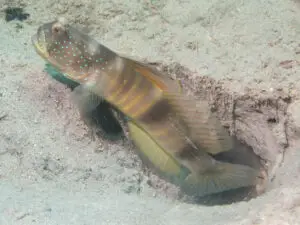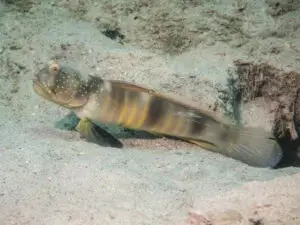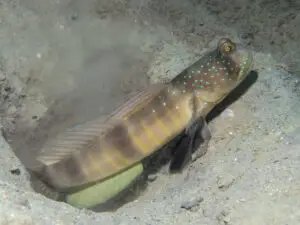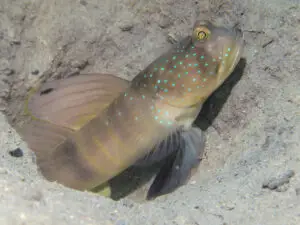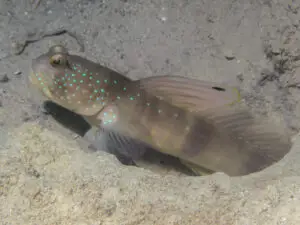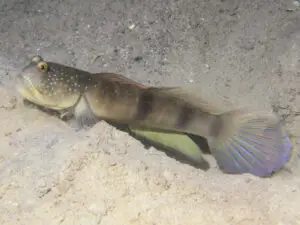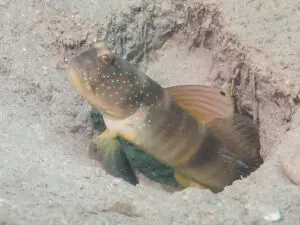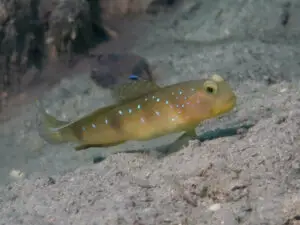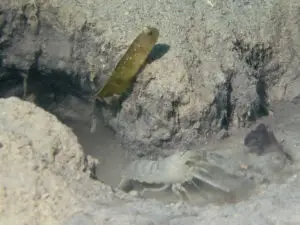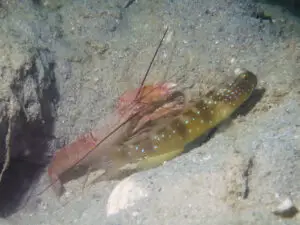Cebu Shrimpgoby
Cryptocentrus cebuanus

Cebu Shrimpgoby
Cryptocentrus cebuanus
Herre, 1927
Description
Body design This is a large species growing up to about 12 cm long. The body is brown with a distinct yellow tinge, darker above and lighter below. Along its length there are about 12 golden vertical bars and evenly spaced between these are five broad brown bars, the first anterior to the first dorsal fin and the last on the caudal peduncle. At times a line of dorsal saddles is present, some corresponding to the dark bars and some lying between them.
Head design
The background colour is brown becoming lighter over the gill cover and the nape. Evenly spaced over the cheek and gill cover are small black outlined iridescent blue spots. There is a line of around 4 iridescent blue spots on the upper lip. There is a pigmented groove above the upper lip.
Fin design
The first dorsal fin is much longer than the second and is brown becoming more yellow posteriorly, with a yellow scalloped margin and a black patch distally on the membrane between the first two rays. The second dorsal fin is pale brown becoming translucent distally with purple and blue accentuation of the rays. The caudal fin is curved, light brown with blue and purple accentuation of the rays and a yellow border on the upper half. There is a small black patch distally on the upper part of the caudal fin. The anal fin is translucent distally with a broad yellow midline stripe. The pelvic fin is black with a yellow base from which some yellow colour runs along the rays into the black. The pectoral fins are translucent with a cluster of iridescent blue spots at the base.
Juveniles
subadult fish have the markings of the adult but very juvenile fish tend to be uniform yellow with fewer reflective spots than the adults. The fin design is the same.
Diagnostic features
A large-bodied species with a blunt square head. The yellow bands on the body and the iridescent blue spots on the face are distinctive.
Similar species
The single black spot on the top of the first dorsal fin separates this species from the similar C. pavoninoides which has 4 black spots and occurs from Thailand to Indonesia.
Natural History
Habitat
We have found them in 5 to 8m on fine silty sand in a sheltered bay at Low Isles.
Behaviour
We observed a sudden invasion of this species for several weeks in February 2016 when we counted 8 large adult individuals on a single dive in an area that we had been monitoring for the previous year and that had none of this species 1 week earlier. They appeared to have commandeered the burrows of the locally common Giant Shrimpgobies, Amblyeleotris fontanesii, and perhaps the Bluelined Shrimpgoby, Cryptocentrus bulbiceps, both are similarly large-sized species with large shrimps. After 2 weeks they had gone again. We have found several juveniles at other times of the year and they tend to stay for longer (January, April and May). This large shrimpgoby is surprisingly shy and wary.
Distribution
Published distribution:. Indonesia, the Philippines and northern Australia.
Our records: Low Isles on the northern Great Barrier Reef.
Associated Shrimp species
Associated Shrimps (two shrimps)
Blue Nipper Snapping Shrimp, Alpheus cf digitalis
Violet Snapping Shrimp, Alpheus fenneri

